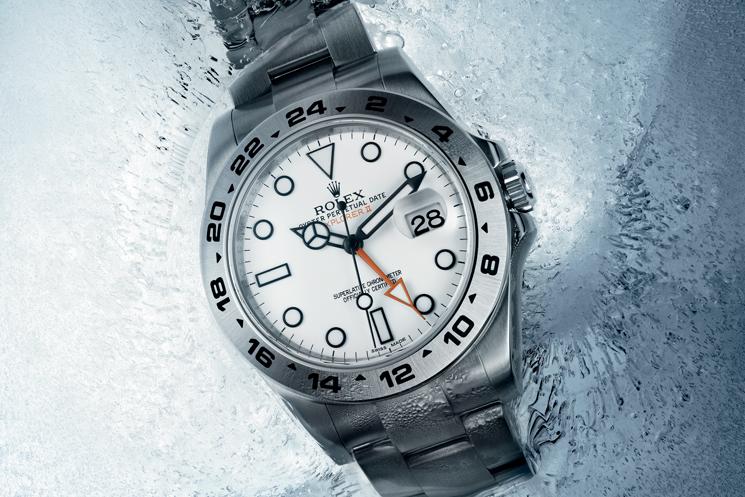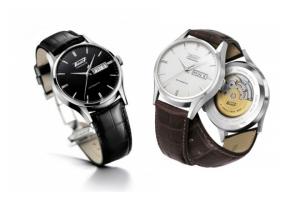Rolex Explorer II: The Brand’s Most Underrated Tool Watch?

When you hear the word Rolex, you’d most likely associate it with luxury and success. Due to its popularity, even the general public knows and recognises the brand. While it assumes fame through flagship models such as the Rolex Submariner and Rolex Datejust, it’s easy to get lost among the brand’s models, with others parading behind the more popular collections. One of those is the Rolex Explorer II — a true sleeping giant with great potential and remarkable value.
A lot of people remain unaware of Rolex Explorer II’s real worth. The collection spans years of development, making this timepiece robust and reliable. However, its cut-rate value persists as compared to other Rolex watches. Sure, it met a few markups in the past years, but it remains within the modestly priced margin of Rolex watches. But that’s not to say that the Rolex Explorer II rests, in any way, inferior among its more expensive counterparts. It, in fact, possesses characteristics unparalleled to its peers.
With that said, let’s find out how the Explorer II remains a constant choice for professionals. And by professionals, we don’t mean nine-to-five executives. We’re talking about speleologists, volcanologists, and polar explorers. Even so, how does the Explorer II continue to prove itself worthy of its niche following? Why does it deserve more recognition than it already boasts?

Specs of the Rolex Explorer II
Before we begin, let’s take a quick peek at the underrated specs of the Rolex Explorer II, particularly the Ref. 216570.
Model Case — 42mm Oystersteel with a monobloc middle case, screw-down case back and winding crown, 24-hour graduated fixed bezel, screw-down crown with Twinlock double waterproofness system, scratch-resistant sapphire with a Cyclops lens over the date, waterproof to 100m/330 feet
Dial — white or black with 18K gold hour indexes and a Chromalight display with blue luminescence on hour indexes and hands
Movement — Rolex Calibre 3187 movement with bidirectional self-winding via a Perpetual rotor with a Parachrom hairspring and 48-hour power reserve. Indicates central hour, minute and seconds with a 24-hour display, independently set; COSC-certified chronometer

History of the Rolex Explorer II
Since the 1930s, Rolex has been equipping explorers in their expeditions with Oyster watches. Through this, Rolex garnered crucial feedbacks that the brand took into account in developing their new category of watches. Enter the Professional category of Rolex watches. These set of timepieces primarily served as tools, and among them includes the Rolex Explorer II.
Developing the Rolex Explorer
The expedition that started what would become the Rolex Explorer happened at the Everest. In the 1953 British Mount Everest expedition, Rolex equipped the team to success. Led by Sir John Hunt, the team that comprised Sir Edmund Hillary and Tenzing Norgay became the first to summit the world’s highest mountain peak.

Through the key feedbacks from the climbers and other information Rolex gained from the Everest expedition, the brand launched the Explorer. The Rolex Explorer featured a legible dial even in extreme conditions. It was a simple watch that only showcased a time-only display — three hands without a date window. Rolex didn’t change it much through its evolution, as you’d witness later. This type of timepiece doesn’t only work for the polar explorers but also for speleologists who spend much of their time in pitch-dark caves.
The Rolex Explorer II Models
There are not a lot of Rolex Explorer II models that were launched. Unlike the Submariner, this model didn’t get a new reference every two years or so. However, the improvements in each new reference are so stark from each other. Let’s dive into the models one by one and see how the Explorer II evolved from an adventurer’s watch to a Holy Grail sports watch that every gentleman deserves.

Rolex Explorer II Ref. 1655
In 1971, with more improvements made with the Explorer, the Rolex Explorer II Ref. 1655 was launched. Rolex made this bigger than its predecessor, sporting a 39mm stainless steel case. It also includes a date window at 3 o’clock that was missing in its previous iteration.
More improvements include a 24-hour markings on the fixed bezel. Combined with the orange 24-hour hand, its wearer can easily identify what time of day or night it was. The timepiece proved extremely useful in pitch-dark caves or areas with no reference for time. The bezel, albeit not luminous, remained functional in darkness. Through the luminescent markers every five minutes and 2.5 minutes too, reading the 24-hour time made it easier for its wearer.
However, the Explorer II Ref. 1655 is not a dual time watch since its bezel is fixed. Despite housing the Rolex calibre 1570/1575, same as the GMT-Master, it still didn’t have a second time zone as reference. This was a big letdown for the market that’s why it didn’t sell as much. Learning from this, we now witness Rolex initiating this necessary improvement on later models.

Rolex Explorer II Refs. 16550 and 16570
The Explorer II Ref. 16550 served as the ‘transitional reference’ for the Explorer II series. With that said, this reference bear the same features of its predecessor, but with modifications made for improvement. Introduced in 1985, the Explorer II Ref. 16550 innovated with a larger case at 40mm to steer away from the ‘busy’ dial of the Ref. 1655. With the sapphire crystal and an option for a white dial, it truly became a new and enhanced version of itself.
To further improve the Ref. 1655, it had a revamped dial with a sportier look. The lume-filled markers had a combination of triangle, round, and rectangular shapes. It had that Mercedes-style hands, similar to other sports watch models. The 24-hour hand, longer and thinner, allowed independent adjustment from the centre hands with the Rolex Calibre 3085. From there, the Explorer II became a GMT watch.
Launched four years later in 1989, the Rolex Explorer II Ref. 16570 cemented the improvements made from the Ref. 16550. Powered by the Calibre 3185 in the earlier models, the later models upgraded with the Calibre 3186. The timepiece remained in production for 22 years until it was replaced by the current Ref. 216570 in 2011.
Nicknames: Polar Explorer, Freccione, Steve McQueen Rolex
The Explorer II gained various nicknames since its introduction in the 1970s. Among those include the ‘Polar Explorer’ for the white dial version of the timepiece. The nickname perfectly embodied not only the history of the watch but also the striking look of the white dial.
Despite it not being a bestseller, collectors give special regard to the Explorer II ref. 1655. Insiders refer to it as the ‘Freccione’, coming from the Italian word ‘freccia’, which means arrow. This is a reference to the orange — and later red — arrow-tipped hand.
Others even refer to this timepiece as the ‘Steve McQueen Rolex’. However, there isn’t any photographic evidence that McQueen wore or owned an Explorer II. In fact, Steve McQueen’s Rolex of choice was a Submariner. But, as all Rolex nicknames go, it stuck to many people and so the misnomer began. Just as with the ‘Pepsi’ or the ‘Hulk’, these nicknames are still referred to by many collectors to this day.
Given this, the first Explorer II also became a rare timepiece and boosted its price in the secondhand market. Its price skyrocketed to at least twice the original selling price, making it available for more than $20,000 at the least.

Rolex Explorer II Ref. 216570
During the 40th anniversary of the Explorer II in 2011, Rolex launched the Explorer II Ref. 216570. Although it’s a modern, revamped new model, traces of the Ref. 1655 still appears on the watch. Much like with its predecessor, the Ref. 216570 had two versions of the dial. It’s available in either a white (Rolex Submariner II Ref. 216570WSO) or black (Rolex Explorer II Ref. 216570BKSO) dial. As with the Freccione, it also has an orange-tipped 24-hour hand. This is different from the thin red arrow on the Explorer II Ref. 16550 and 16570. To match this, the ‘Explorer II’ on the dial is also printed in orange.
The largest Explorer II yet, the Ref. 216570 boast a 42mm steel Oyster case. This gives the watch more space for bigger indexes, hands and even brighter lume for optimum legibility.
Powering the watch is the self-winding Rolex calibre 3187. The movement, manufactured in-house by the brand, features a Parachrom hairspring and Paraflex shock absorbers. Extreme conditions are no match with the modern-day Explorer II, proving itself as the more durable version of its series. This version of the Explorer II truly is the best yet.
Perfect for adventurers and globetrotters, the Ref. 216570 features a dual time display. This makes it more reliable than the Ref. 1655. And as proof of the movement’s reliability, it’s awarded as a Superlative Chronometer with an accuracy of -2/+2 sec/day. The same movement can be seen on the Datejust, Deepsea Sea-Dweller, and the Yacht-Master.
The Future of Explorer II Watches
Given that the Rolex Calibre 3187 isn’t exactly a new movement and with all the improvements in Rolex these past years, the word goes out that a new Explorer II is in development. When will it be released? No one knows exactly. Rolex has been known for providing staggering improvements on timepieces through new reference models, but the change is usually worth every second of the wait.
What are we looking for with the new Explorer II watch? Perhaps, the most requested improvement is the Cerachrom bezel. Launched in 2005, the Cerachrom is a combination of the words ‘ceramic’ and ‘chrom’, the word for ‘colour’ in Greek. This patented ceramic production technology makes Rolex a stand out brand even with all the new technology its competitors put out. Cerachrom is a very robust material that could further strengthen the Explorer II’s status as an adventurer’s watch. It also makes it even more durable and aesthetically pleasing. It makes fading virtually impossible as compared to an aluminium insert bezel.
Most Rolex watches already employ the use of Cerachrom including the Submariner, GMT-Master II, Sea-Dweller, and Yacht-Master II.

Pricing
As aforementioned, the Explorer II is unbeatable when it comes to affordability. The typical selling price of the Rolex Explorer II Ref. 216570 is at less than $10,000. It’s not as rare as other Rolex watches, but it definitely isn’t as plenty either. Rolex has been rolling back on steel watches, perhaps to boost its prices. Authorised dealers suffer greatly because of this.
On the contrary, the secondhand market brims with Explorer II watches. This opened up a new market for the timepiece that is slowly becoming a favourite among collectors. The then-weak demand for this watch is growing with great stability so you’ll most likely find a pre-owned Explorer II on classified sites for less.
As years go by, the price of Explorer II continues to go up, especially for the vintage models. So, purchasing a new Explorer II now may be good as an investment.
Final Thoughts
The Explorer II has sure come a long way from its humble ‘time-only display’ beginnings. For a tool watch that comes from a luxury watch brand like Rolex, this timepiece offers great function in such a majestic form. While you can’t expect the same elegance from a Rolex Daytona or a Datejust, it’s a perfect alternative for more expensive tool watches from the same brand. Perhaps, the Rolex Explorer II is the ultimate Rolex sports watch and more people are realising it by now.
The timepiece that was once exclusive for explorers of the mighty polar as well as the shadowy caves is now becoming every gentleman’s choice for a sports watch. It’s not surprising given that it only costs a fraction of a price of the Submariner or Yacht-Master II.
Can’t get enough of Rolex? We have a whole bunch of Rolex guides for you. Check out our comprehensive guides on the New Rolex Oyster Perpetual Models, Rolex Datejust 41, and vintage Rolex watches!
Photo credits: Featured | In-Article Photos


